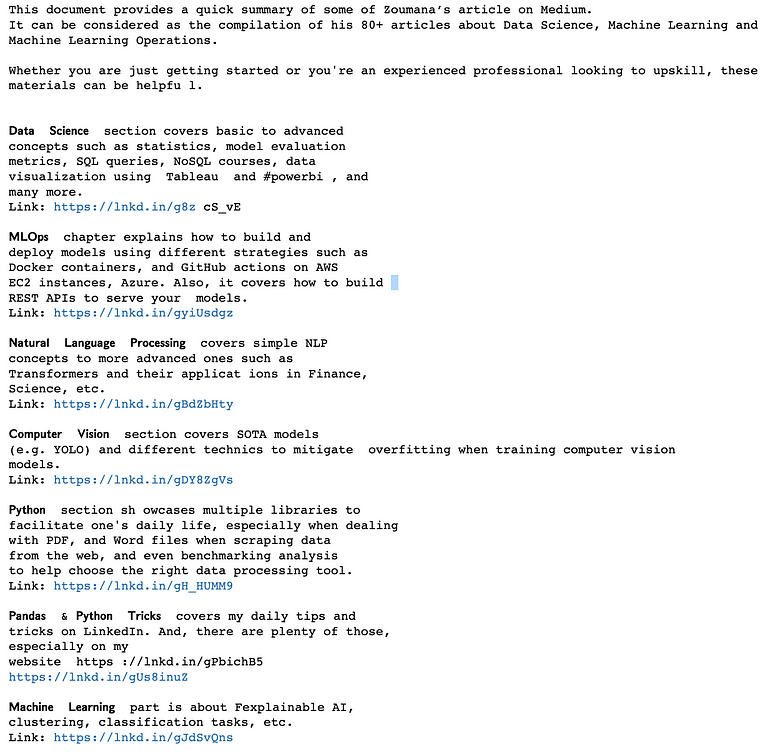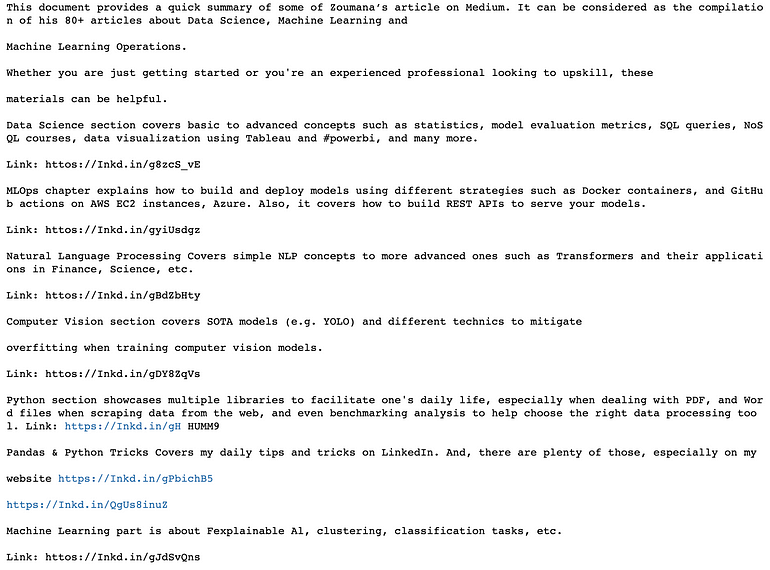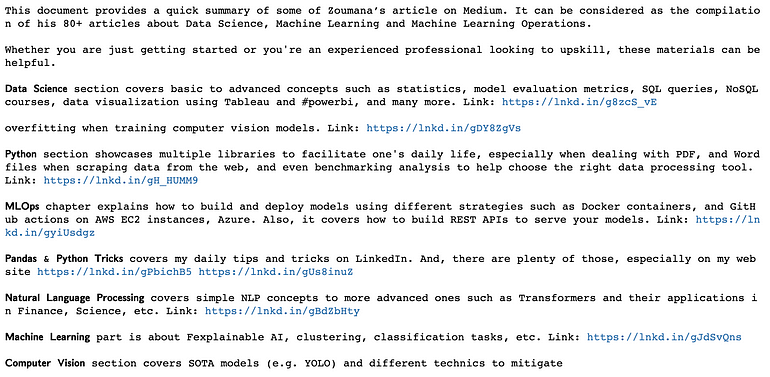大型语言模型已经席卷了互联网,导致更多的人没有认真关注使用这些模型最重要的部分:高质量的数据!
本文旨在提供一些有效从任何类型文档中提取文本的技术。
Python库
本文专注于Pytesseract、easyOCR、PyPDF2和LangChain库。实验数据是一个单页PDF文件,可在以下链接获取:
https://github.com/keitazoumana/Experimentation-Data/blob/main/Experimentation_file.pdf
由于Pytesseract和easyOCR可以处理图像,因此在执行内容提取之前需要将PDF文件转换为图像。可以使用pypdfium2进行转换,这是一个用于处理PDF文件的强大库,其实现如下:
pip install pypdfium2
以下函数以PDF作为输入,并将PDF的每一页作为图像列表返回。
def convert_pdf_to_images(file_path, scale=300/72):pdf_file = pdfium.PdfDocument(file_path)page_indices = [i for i in range(len(pdf_file))]renderer = pdf_file.render(pdfium.PdfBitmap.to_pil,page_indices = page_indices, scale = scale,)final_images = [] for i, image in zip(page_indices, renderer):image_byte_array = BytesIO()image.save(image_byte_array, format='jpeg', optimize=True)image_byte_array = image_byte_array.getvalue()final_images.append(dict({i:image_byte_array}))return final_images
现在,我们可以使用`display_images`函数来可视化PDF文件的所有页面。
def display_images(list_dict_final_images):all_images = [list(data.values())[0] for data in list_dict_final_images]for index, image_bytes in enumerate(all_images):image = Image.open(BytesIO(image_bytes))figure = plt.figure(figsize = (image.width / 100, image.height / 100))plt.title(f"----- Page Number {index+1} -----")plt.imshow(image)plt.axis("off")plt.show()
通过组合上述两个函数,我们可以得到以下结果:
convert_pdf_to_images = convert_pdf_to_images('Experimentation_file.pdf')
display_images(convert_pdf_to_images)
 PDF以图像格式可视化
PDF以图像格式可视化
深入文本提取过程
Pytesseract
Pytesseract(Python-tesseract)是用于从图像中提取文本信息的Python OCR工具,可以使用以下pip命令进行安装:
pip install pytesseract
以下的辅助函数使用了 Pytesseract 的 `image_to_string()` 函数从输入图像中提取文本。
from pytesseract import image_to_string
def extract_text_with_pytesseract(list_dict_final_images):image_list = [list(data.values())[0] for data in list_dict_final_images]image_content = []for index, image_bytes in enumerate(image_list):image = Image.open(BytesIO(image_bytes))raw_text = str(image_to_string(image))image_content.append(raw_text)return "\n".join(image_content)
可以使用 `extract_text_with_pytesseract` 函数提取文本,如下所示:
text_with_pytesseract = extract_text_with_pytesseract(convert_pdf_to_images)
print(text_with_pytesseract)
成功执行以上代码将生成以下结果:
This document provides a quick summary of some of Zoumana’s article on Medium.
It can be considered as the compilation of his 80+ articles about Data Science, Machine Learning and
Machine Learning Operations.
...
Pytesseract was able to extract the content of the image.
Here is how it managed to do it!
Pytesseract starts by identifying rectangular shapes within the input image from top-right to bottom-right. Then it extracts the content of the individual images, and the final result is the concatenation of those extracted content. This approach works perfectly when dealing with column-based PDFs and image documents.
...
Pytesseract 首先通过从图像的右上角到右下角识别矩形形状。然后它提取各个图像的内容,最终的结果是这些提取内容的串联。这种方法在处理基于列的 PDF 和图像文档时效果非常好。
easyOCR
easyOCR 也是一个用于光学字符识别的开源 Python 库,目前支持提取 80 多种语言的文本。easyOCR需要安装Pytorch 和 OpenCV,可以使用以下指令安装:
!pip install opencv-python-headless==4.1.2.30
根据您的操作系统,安装 Pytorch 模块的方法可能不同。但所有的说明都可以在官方页面上找到。现在我们来安装 easyOCR 库:
!pip install easyocr
在使用 easyOCR 时,因为它支持多语言,所以在处理文档时需要指定语言。通过其 Reader 模块设置语言,指定语言列表。例如,fr 用于法语,en 用于英语。语言的详细列表在此处可用。
from easyocr import Reader# Load model for the English language
language_reader = Reader(["en"])
文本提取过程在`extract_text_with_easyocr` 函数中实现:
def extract_text_with_easyocr(list_dict_final_images):image_list = [list(data.values())[0] for data in list_dict_final_images]image_content = []for index, image_bytes in enumerate(image_list):image = Image.open(BytesIO(image_bytes))raw_text = language_reader.readtext(image)raw_text = " ".join([res[1] for res in raw_text])image_content.append(raw_text)return "\n".join(image_content)
我们可以如下执行上述函数:
text_with_easy_ocr = extract_text_with_easyocr(convert_pdf_to_images)
print(text_with_easy_ocr)
 easyOCR 的结果
easyOCR 的结果
与 Pytesseract 相比,easyOCR 的效果似乎不太高效。例如,它能够有效地读取前两个段落。然而,它不是将每个文本块视为独立的文本,而是使用基于行的方法进行读取。例如,第一个文本块中的字符串“Data Science section covers basic to advanced”已与第二个文本块中的“overfitting when training computer vision”组合在一起,这种组合完全破坏了文本的结构并使最终结果产生偏差。
PyPDF2
PyPDF2 也是一个专门用于 PDF 处理任务的 Python 库,例如文本和元数据的检索、合并、裁剪等。
!pip install PyPDF2
提取逻辑实现在 `extract_text_with_pyPDF` 函数中:
def extract_text_with_pyPDF(PDF_File):pdf_reader = PdfReader(PDF_File)raw_text = ''for i, page in enumerate(pdf_reader.pages):text = page.extract_text()if text:raw_text += textreturn raw_text
text_with_pyPDF = extract_text_with_pyPDF("Experimentation_file.pdf")
print(text_with_pyPDF)

使用 PyPDF 库进行文本提取
提取过程快速而准确,甚至保留了原始字体大小。PyPDF 的主要问题是它不能有效地从图像中提取文本。
LangChain
LangChain 的 UnstructuredImageLoader 和 UnstructuredFileLoader 模块可分别用于从图像和文本/PDF 文件中提取文本,并且在本节中将探讨这两个选项。
首先,我们需要按照以下方式安装 langchain 库:
!pip install langchain
从图像中提取文本
from langchain.document_loaders.image import UnstructuredImageLoader
以下是提取文本的函数:
def extract_text_with_langchain_image(list_dict_final_images):image_list = [list(data.values())[0] for data in list_dict_final_images]image_content = []for index, image_bytes in enumerate(image_list):image = Image.open(BytesIO(image_bytes))loader = UnstructuredImageLoader(image)data = loader.load()raw_text = data[index].page_contentimage_content.append(raw_text)return "\n".join(image_content)
现在,我们可以提取内容:
text_with_langchain_image = extract_text_with_langchain_image(convert_pdf_to_images)
print(text_with_langchain_image)
 来自 langchain UnstructuredImageLoader 的文本提取
来自 langchain UnstructuredImageLoader 的文本提取
该库成功高效地提取了图像的内容。
从 PDF 中提取文本
以下是从 PDF 中提取内容的实现:
from langchain.document_loaders import UnstructuredFileLoader
def extract_text_with_langchain_pdf(pdf_file):loader = UnstructuredFileLoader(pdf_file)documents = loader.load()pdf_pages_content = '\n'.join(doc.page_content for doc in documents)return pdf_pages_content
text_with_langchain_files = extract_text_with_langchain_pdf("Experimentation_file.pdf")
print(text_with_langchain_files)
类似于 PyPDF 模块,langchain 模块能够生成准确的结果,同时保持原始字体大小。

从 langchain 的 UnstructuredFileLoader 中提取文本
技术交流
建了技术交流群!想要进交流群、获取原版资料的同学,可以直接加微信号:dkl88194。加的时候备注一下:研究方向 +学校/公司+CSDN,即可。然后就可以拉你进群了。
方式①、添加微信号:dkl88194,备注:来自CSDN + 技术交流
方式②、微信搜索公众号:Python学习与数据挖掘,后台回复:加群
资料1

资料2







】递归)












